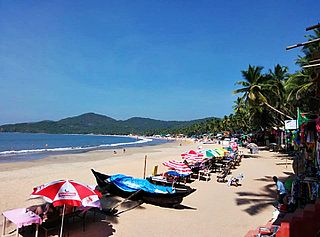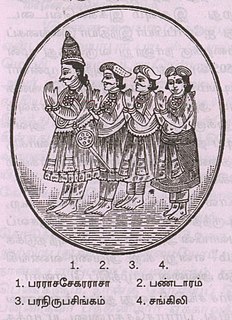
The Aryacakravarti dynasty were kings of the Jaffna Kingdom in Sri Lanka. The earliest Sri Lankan sources, between 1277 and 1283, mention a military leader of this name as a minister in the services of the Pandyan Empire; he raided the western Sri Lankan coast and took the politically significant relic of the Buddha’s tooth from the Sinhalese capital city of Yapahuwa. Political and military leaders of the same family name left a number of inscriptions in the modern-day Tamil Nadu state, with dates ranging from 1272 to 1305, during the late Pandyan Empire. According to contemporary native literature, such as Cekaracecekaramalai, the family also claimed lineage from the Tamil Brahmins of the prominent Hindu pilgrimage temple of Rameswaram in the modern Ramanathapuram District of India. They ruled the Jaffna kingdom from the 13th until the 17th century, when the last of the dynasty, Cankili II, was ousted by the Portuguese.

Chandrabhanu or Chandrabhanu Sridhamaraja was the King of Tambralinga Kingdom in present-day Thailand, Malaysia and Sumatra. A Javaka, he was known to have ruled from during the period of 1230 until 1263. He was also known for building a well-known Buddhist stupa in southern Thailand. He spent more than 30 years in his attempt to conquer Sri Lanka. He was eventually defeated by the forces of the Pandyan Dynasty from Tamil Nadu in 1263 and was killed by the brother of the south Indian Emperor Jatavarman Sundara Pandyan.

The Kingdom of Kandy was an independent monarchy of the island of Sri Lanka, located in the central and eastern portion of the island. It was founded in the late 15th century and endured until the early 19th century.

The American Ceylon Mission (ACM) to Jaffna, Sri Lanka started with the arrival in 1813 of missionaries sponsored by the American Board of Commissioners for Foreign Missions (ABCFM). The British colonial office in India and Ceylon restricted the Americans to the relatively small Jaffna Peninsula for geopolitical reasons for almost 40 years. The critical period of the impact of the missionaries was from the 1820s to early 20th century. During this time, they engaged in original translations from English to Tamil, printing, and publishing, establishing primary, secondary and tertiary educational institutions and providing health care for residents of the Jaffna Peninsula. These activities resulted in many social changes amongst Sri Lankan Tamils that survive even today. They also led to the attainment of a lopsided literacy level among residents in the relatively small peninsula that is cited by scholars as one of the primary factors contributing to the recently ended civil war. Many notable educational and health institutions within the Jaffna Peninsula owe their origins to the missionary activists from America. Missionaries also courted controversy by publishing negative information about local religious practices and rituals.

Cankili II was the self-proclaimed last king of the Jaffna kingdom and was a usurper who came to throne with a palace massacre of the royal princess and the regent Arasakesari in 1617. His regency was rejected by the Portuguese colonials in Colombo, Sri Lanka. His reign was secured with military forces from the Thanjavur Nayaks and Karaiyar captains. He was defeated by the Portuguese in 1619 and was taken to Goa and hanged. With his death the Aryacakravarti line of Kings who had ruled the kingdom for over 300 years came to an end.

Puviraja Pandaram ruled the Jaffna kingdom during a period of chaos during and after the death of his father Cankili I in 1565. He became king in 1561 following a local uprising against Cankili I. Although he was the nominal king, Cankili I wielded real power behind the throne until his death in 1565. After Cankili's death, Puviraja Pandaram lost power to one Kasi Nainar and Periyapillai. After the death or abdication of Periyapillai in 1582, Puviraja Pandarm was nominated as the king for the second time.
Phillippe de Oliveira or Filipe de Oliveira was the conqueror of the Jaffna Kingdom in northern modern day Sri Lanka on behalf of the Portuguese Empire in 1619. He stayed behind as the captain-major of the conquered kingdom until his death in 1627. His instructions were to collect the tribute due from the last indigenous king of the Kingdom Cankili II but a chance encounter lead to a sharp but brief battle that led to the defeat of Cankili II. By his order, Cankili II was killed by Hanging and Cankili's remaining soldiers were executed by decapitation. His rule over the Jaffna Kingdom is remembered both for the destruction of over 500 Hindu temples and the forced conversion of the natives to the Roman Catholic religion as well as for his efforts in controlling and moderating the desire of colonial officials in Colombo and Goa to incessantly increase taxes on the local population. After his death, the taxation policy followed by the Portuguese colonial rulers led to the de-population of the Jaffna peninsula.
Migapulle Arachchi also known as Chinna Migapillai, was a feudal lord from the Jaffna Kingdom who became a rebel leader just after its annexation by the Portuguese Empire in 1619. His title Arachchi, is a title given to the commanders of Lascarins or native military forces.
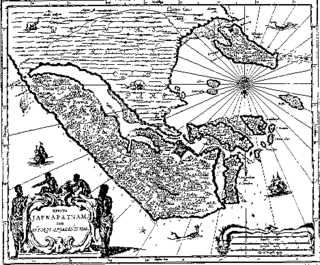
The Portuguese conquest of the Jaffna kingdom occurred after Portuguese traders arrived at the rival Kotte Kingdom in the southwest of modern Sri Lanka in 1505. Many kings of Jaffna, such as Cankili I, initially confronted the Portuguese in their attempts at converting the locals to Roman Catholicism, but eventually made peace with them.

The Kingdom of Sitawaka was a kingdom located in south-central Sri Lanka. It emerged from the division of the Kingdom of Kotte following the Spoiling of Vijayabahu in 1521, and over the course of the next seventy years came to dominate much of the island. Sitawaka also offered fierce resistance to the Portuguese, who had arrived on the island in 1505. Despite its military successes, Sitawaka remained unstable, having to contend with repeated uprisings in its restive Kandyan territories, as well as a wide-ranging and often devastating conflict with the Portuguese. Sitawaka disintegrated soon after the death of its last king Rajasimha I in 1593.
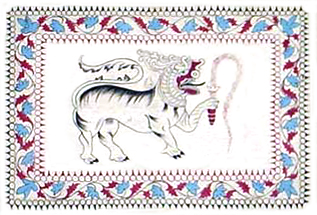
The Kingdom of Kotte, centered on Sri Jayawardenepura Kotte, was a kingdom that flourished in Sri Lanka during the 15th century.

Portuguese Ceylon was the control of the Kingdom of Kotte by the Portuguese Empire, in present-day Sri Lanka, after the country's Crisis of the Sixteenth Century and into the Kandyan period.
When to date the start of the history of the Jaffna kingdom is debated among historians.
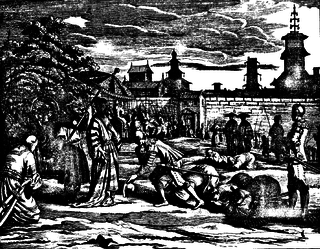
The Sinhalese–Portuguese War was a series of conflicts waged from 1527 to 1658 between the indigenous Sinhalese kingdoms of Ceylon and their allies against the Portuguese Empire. The Portuguese were seeking to expand from their trading post at Colombo to incorporate Ceylon into their growing empire.

André Furtado de Mendonça was a captain and governor of Portuguese India, and a military commander during Portuguese expansion into Ceylon, India, Indonesia and Malacca.

This is a bibliography of works on Sri Lanka.
The Portuguese invasion of Jaffna kingdom in 1560 AD was the first expedition against the Jaffna kingdom by the Portuguese Empire. It was led by Viceroy Dom Constantino de Bragança and resulted in the capture of the capital, Nallur. The king of Jaffna, Cankili I, managed to escape and regained the capital through a pact that he made with the Portuguese. He subsequently incited a peoples' rebellion against the Portuguese, resulting in their withdrawing their forces from Nallur. The Jaffna kingdom, however, lost its sovereignty over Mannar Island and its main town, Mannar.




